Table of Contents
- What is post-purchase customer support?
- What is the post-purchase behavior of customers?
- Why is post-purchase customer experience Important?
- How to build lifelong customer relationships
- How to respond more quickly (while staying relevant and helpful)
- Download the report for more post-purchase customer support insights
- FAQs
- What are the 5 R's of customer service?
- What is post-sale customer service?
Customers use social media across the entire buying journey (if you read on, I’ll point you to some interesting new numbers in a fresh report that’s just come out.) But they expect slightly different things on each of the stages.
Let’s take a look at how you can consistently meet their expectations and what tools can help you provide great customer service.
- What is post-purchase customer support?
- What is the post-purchase behavior of customers?
- Why is post-purchase customer experience Important?
- How to build lifelong customer relationships
- How to respond more quickly (while staying relevant and helpful)
- Download the report for more post-purchase customer support insights
- FAQs
- What are the 5 R's of customer service?
- What is post-sale customer service?

The Best Tool for Social Media Customer Support
Seamlessly manage and automate customer interactions across social media in one customizable dashboard with NapoleonCat – the all-in-one solution for Facebook, Instagram, TikTok, LinkedIn, YouTube, and more.
What is post-purchase customer support?
I know many businesses would love that, but your job is not done when a customer hits that “Buy Now” button. Because what happens after that is also really important – at least if you want to retain customers, have them recommend your products to others, and build customer loyalty.
And that’s where post-purchase customer support comes in. It’s all about making sure buyers feel good about their decision, get any help they need, and become loyal fans of your brand.
Before social media, this usually meant call centers and emails. These days, social media is where a good portion of these conversations are happening. Whether it’s answering questions, resolving issues, or just keeping the conversation going, brands that engage can turn casual buyers into lifelong customers.
And, yes, I have receipts. The 2025 study of UK consumers by Norstat and NapoleonCat found that social media is one of the top ways people reach out to brands, beating website contact forms and live chats, with Facebook, YouTube, and Instagram as the go-to platforms.
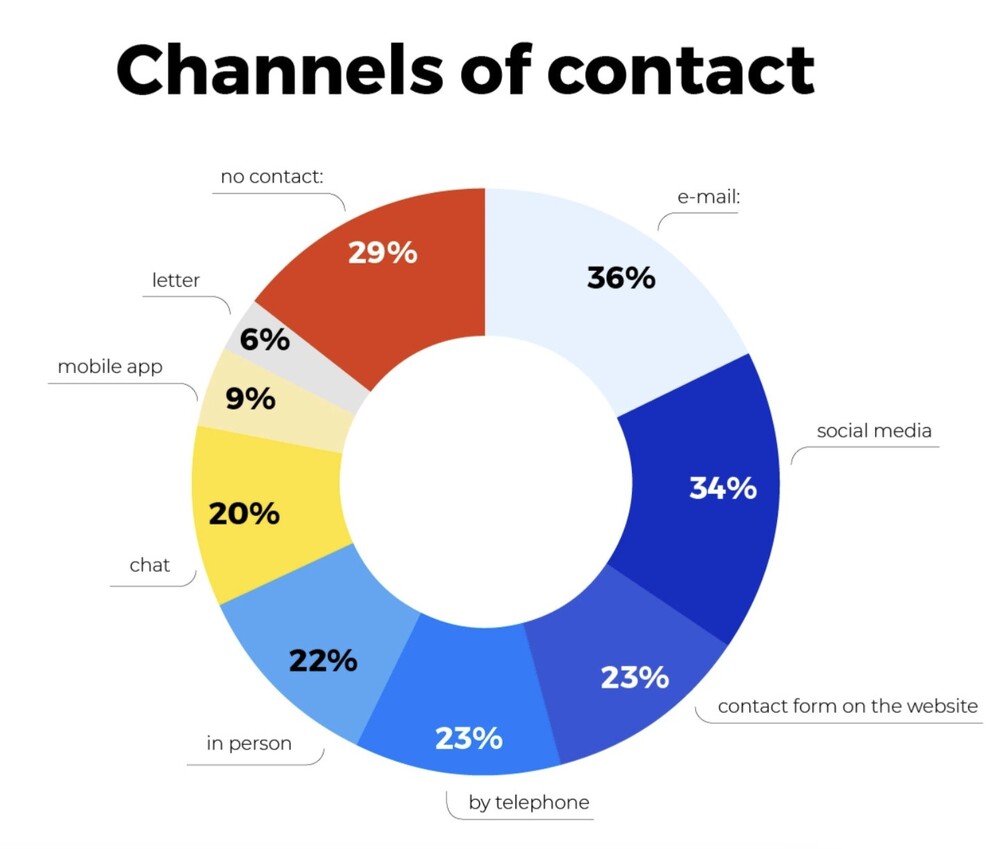
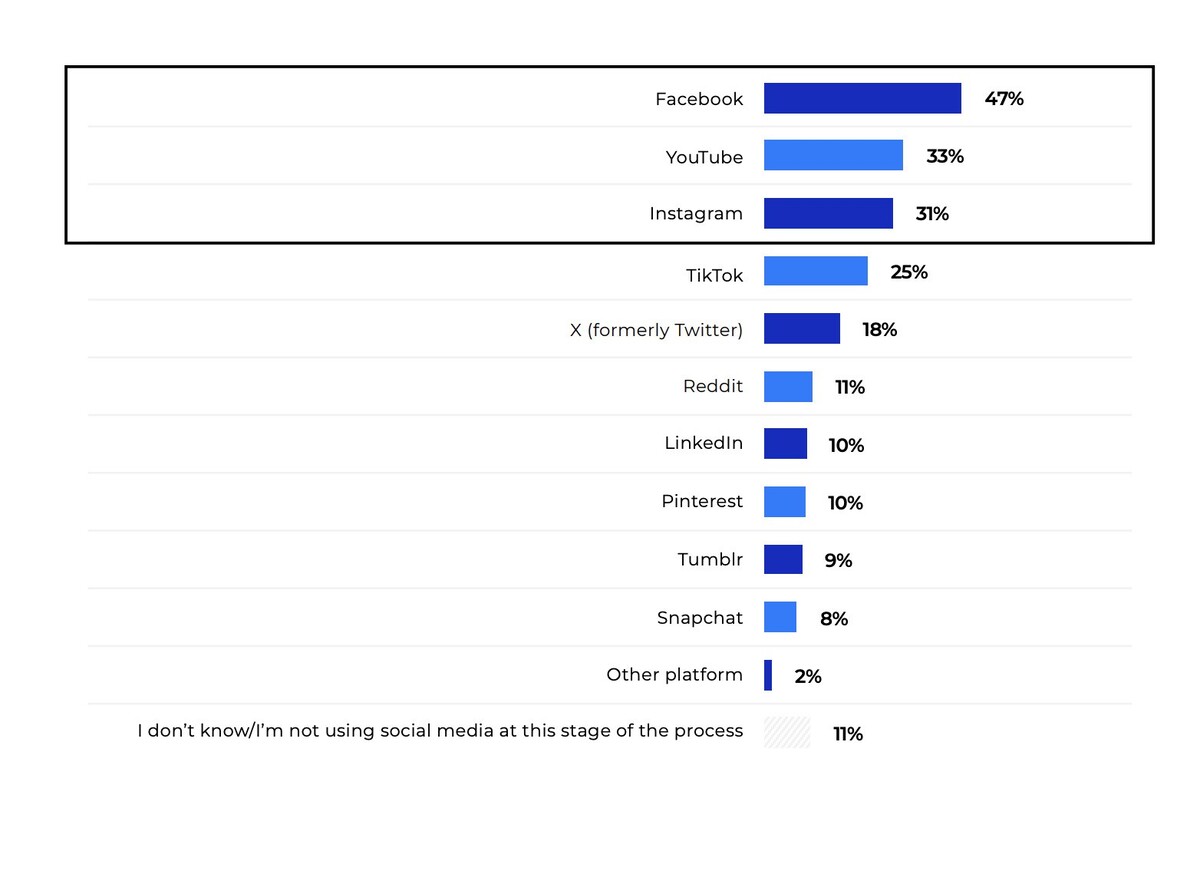
Let me show you some more details of the report below – and you can download the whole thing here to learn about the different ways customers engage with brands on different social media platforms across the buying cycle and what you can do to capitalize on it.
What is the post-purchase behavior of customers?
After buying from you, customers go through a few emotional and behavioral stages:
- Post-purchase evaluation: They start analyzing if they made the right choice, sometimes comparing it with past buys or checking out more reviews.
- Buyer’s remorse (aka second thoughts): Some customers feel a bit of regret or doubt. This is when a little extra reassurance from a brand can go a long way.
- Seeking help: If they have questions or run into an issue, social media is often their first stop. They might either contact the brand or ask others for advice or recommendations.
- Sharing experiences: Happy customers will sing your praises online, and unhappy ones? Well, they’ll definitely let you (and the world) know. And you might have, well, a problem when they decide to let the world know first.
- Loyalty and repeat purchases: If the experience is smooth and positive, they’re way more likely to come back for more.
Interestingly, 44% of British consumers turn to social media for post-purchase interactions, whether it’s looking for support or simply sharing their thoughts – which might come in different forms, including reviews and unboxing videos.
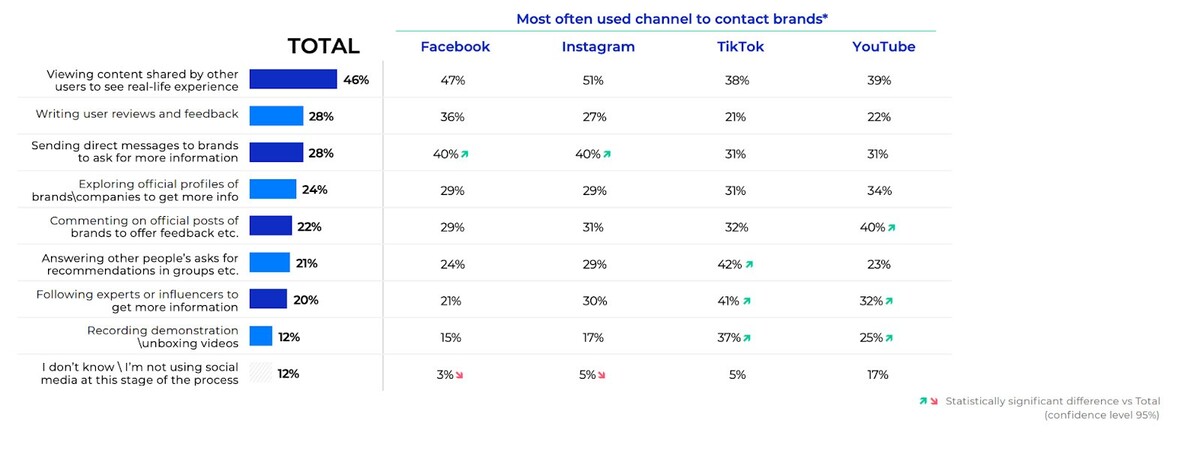

Protect your social media from offensive comments and SPAM
Automatically hide or delete comments containing spam under your organic posts and ads – with an all-in-one social media moderation tool.
Why is post-purchase customer experience Important?
It’s important, at least for several reasons. And it’s more than just fixing potential problems with shipping delays or refunds. How you engage with customers after they buy can have a really big impact on your brand and business.
- Happy customers stick around: Quick, helpful responses mean fewer complaints and more repeat customers.
- Fewer refunds and returns: Many returns happen because customers don’t know how to use the product properly. A little guidance can help.
- Brand advocates are born: When people love their experience, they leave glowing reviews and tell their friends. Plus, other customers who are only just thinking about buying from you get encouragement. (I mean, it’s basically free advertising.)
- Your reputation gets a boost: Being responsive and helpful on social media can become your competitive advantage.
- Valuable feedback: Post-purchase interactions give you insights on how to improve your products and services. (If you’re open to it. You are, right?)
Looking back at the study, 54% of British consumers say that great customer service on social media improves their opinion of a brand. Plus, nearly half expect a response within 5 hours. 👀
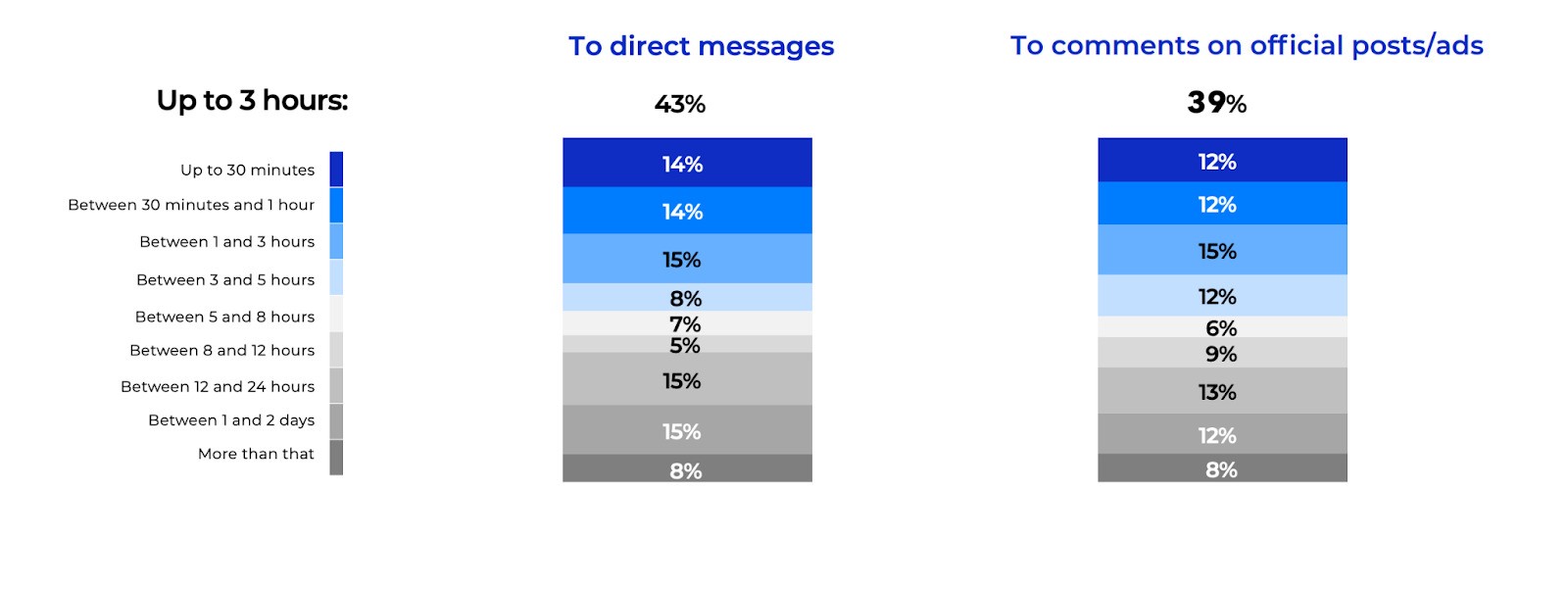
How to build lifelong customer relationships
So, this is a big question. And of course, customers will come and go, and you can influence their behavior of choosing their brand only to a certain extent. But that’s precisely why it’s so important to make the most of that opportunity.
- Be proactive: Don’t wait for complaints. Anticipate issues and offer help before they become problems.
- Respond fast: Social media is all about quick responses. I’ll show you how in a separate section coming right up.
- Make it personal: You can still do it even if you’re using automated moderation. Use a friendly tone, acknowledge their issue, and offer a tailored solution.
- Create helpful content: Tutorials, FAQs, and how-to guides can answer common questions before they’re even asked.
- Share user-generated content: Take advantage of the fact that people already review your products in posts and videos. They might actually appreciate that being noticed by the brand, while other customers will definitely appreciate an honest look by someone other than the brand itself.
- Respond in private when necessary: Address concerns publicly when needed, but take complex issues to private messages. I’ll show you how to do it using NapoleonCat’s Social Inbox and Auto-moderation. ⬇️
- Use automation wisely: AI tools can help respond quickly, but don’t let them replace human connection overall. Use automation to help with simple tasks like responding to frequently asked questions or removing spam, and leave the more complex issues to the post-purchase customer support team (who will now have more time to deal with them.)
- Track and improve: Use social media analytics to identify common issues and refine your support strategy.
The report found that TikTok users are especially likely to answer other customers’ questions and share recommendations. Interestingly, men tend to use multiple contact methods post-purchase, while women are more likely to leave reviews.
(You’ll find more details like this in the report. It not only covers post-purchase support and customer behavior but also covers the entire customer journey.)
How to respond more quickly (while staying relevant and helpful)
To respond to the rising consumer expectations and provide a better customer experience, you need to be ready to reply quickly and helpfully to your customers’ comments and DMs. And if you are an eCommerce company with large volumes of engagement on social media or a marketing agency running social media profiles for multiple clients, you know it’s not going to be easy.
An absolute must is to have tools that will help you manage the engagement volumes, so you can stay profitable while providing excellent customer support.
And one of those tools is NapoleonCat, and, more specifically, two features it offers:
- Social Inbox that lets moderation teams keep tabs on all incoming customer interactions from different social media platforms in one place
- Auto-moderation that lets you handle straightforward cases like repetitive questions or spam removal with automated algorithms.
Let’s take a quick look at both.
Build a consistently great customer experience with the Social Inbox
The Social Inbox is what it sounds like – an inbox with all incoming messages, DMs, and even reviews from:
- TikTok
- Google Business
- YouTube.
- Apple App Store
- Google Play Store
Including comments on ads (which is where upset customers can also leave their mark, while your team might be completely ignorant because someone else manages the ad campaigns.)
Using the Social Inbox, you have all that in one dashboard, from where you can:
- Reply, like, or delete comments and messages, usually much quicker than responding on each social media platform individually.
- Assign them to individual moderators.
- Leave notes for others, so that they have important context.
- Consult a comment thread with a different department or your client’s team, with insights into the entire conversation history.
- You can also monitor moderation performance and response time and create regular moderation reports.
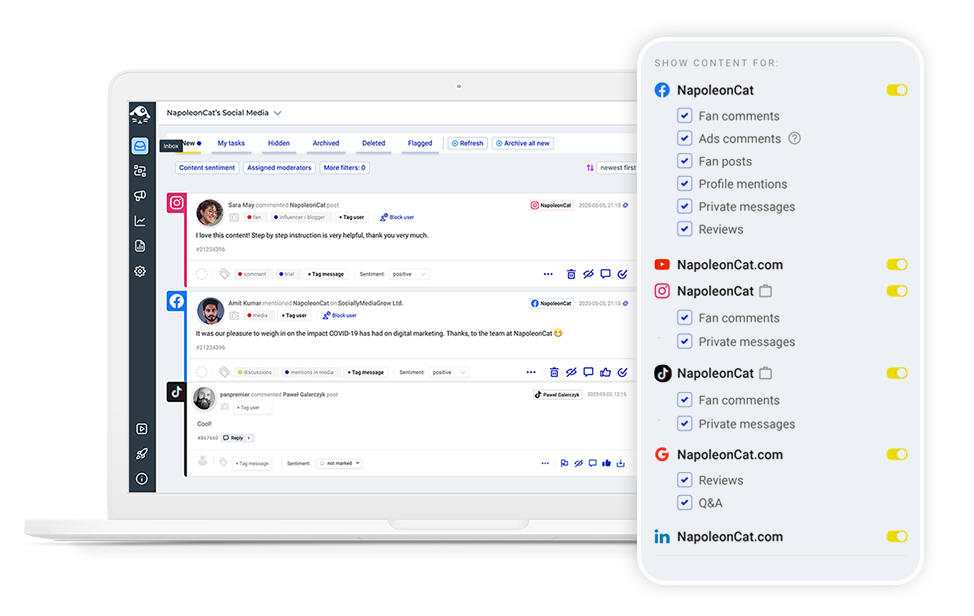
What’s important is that it’s not just about response time alone (which also shows in the study responses.) People want answers quickly, but they want answers that are helpful and relevant.
When you have tools that help manage large volumes of conversations, it’s also easier to pay more attention to those conversations that are more complex and might need more sophisticated solutions.
Automate straightforward conversations to have more time for more complex tasks
With Auto-moderation, you can easily build automated rules that let you perform certain actions based on selected triggers. It works for Facebook, Instagram, TikTok, YouTube, and LinkedIn.
For example, you can:
- Automatically reply to comments with a certain keyword or phrase with a relevant answer (for example, about product size, price, or shipping).
- Automatically send extra content based on a keyword in a comment.
- Automatically remove spam and hate comments based on a list of offensive words and phrases.
- Automatically hide comments with links from under your ads.
- Automatically respond in a private message if the comment includes sensitive details such as order number.
- Automatically moderate ad comments on Facebook, Instagram, and TikTok to solve potential issues and prevent conversion drops caused by negative comments.
Building an Auto-moderation rule is super easy – you fill out pre-built sections, and there are also several ready-made templates that you can customize.
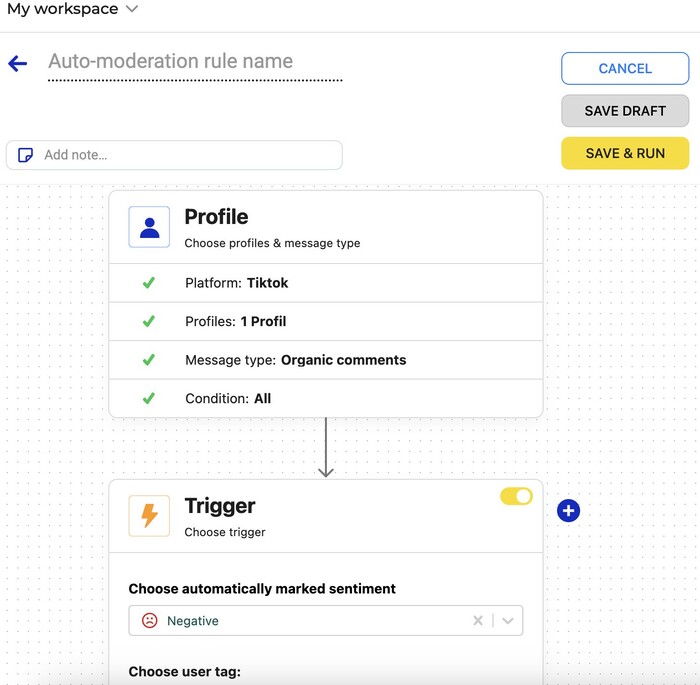
Coupling the Social Inbox as the hub for all customer conversations on social media with Auto-moderation used in specific instances is a really effective way to build great post-purchase customer support that meets people’s expectations.
We highly recommend you test NapoleonCat completely for free here – no credit card required during signup 😉

The Best Tool for Social Media Customer Support
Seamlessly manage and automate customer interactions across social media in one customizable dashboard with NapoleonCat – the all-in-one solution for Facebook, Instagram, TikTok, LinkedIn, YouTube, and more.
Download the report for more post-purchase customer support insights
Beyond just answering questions, social media is a key place where customers engage with brands post-purchase.
According to the study, 44% of British consumers use social media for post-purchase interactions at least occasionally. This means brands need to be prepared to not just offer support but to actively engage with their audience to foster loyalty and elevate the post-purchase experience.
- Customers look for user-generated content: Many buyers check out customer reviews, photos, and unboxing videos before making another purchase. (Think about what that means for your entire customer journey!)
- Influencers matter: TikTok users are more likely to follow influencers post-purchase and engage in product discussions.
- Speed is important: About 40% of consumers expect a brand to respond to their questions within 3 hours, with nearly a quarter expecting a reply within an hour.
- Engagement creates loyalty: Consumers who receive prompt, helpful post-purchase support are far more likely to make repeat purchases and recommend brands to others.
For more details about the importance of social media across the entire customer journey with more interesting stats, download the report “From Likes to Loyalty: The Consumer Journey on Social Media.”
(For example, did you know that men tend to answer other people’s requests for recommendations and record demos or unboxing videos more often than women? 👀 Well, now you do.)
FAQs
What are the 5 R’s of customer service?
You can find at least several versions of the 5 R’s online, so here’s one of them.
- Reliability: Customers expect brands to consistently provide excellent service. Being dependable means keeping promises, delivering quality, and being always available when your customers need you.
- Responsiveness: Responding quickly to customer inquiries, whether through social media, email, or chat, builds trust and boosts customer satisfaction.
- Respect: Treating customers with kindness, understanding, and professionalism (even in situations when that’s not your first instinct) strengthens relationships and improves brand perception.
- Resolution: Solving problems effectively is key in customer support. That’s why it’s not just about responding fast, but also about helping the customer actually deal with the issue at hand.
- Reassurance: Customers want to feel confident in their purchase and their relationship with a brand. Reassuring them through clear communication, follow-ups, and a supportive tone helps maintain loyalty and trust.
What is post-sale customer service?
Post-sale customer service includes everything that happens after someone buys a product or service, from answering product-related questions and processing returns to troubleshooting issues and keeping customers engaged.
On social media, this means responding to DMs, replying to comments, and generally being present for customers when they need you.
You may also like:
- Top 11 Customer Service Tools for a Successful Year
- How to Handle Difficult Customers on Facebook
- How to Boost Customer Service with Instagram DM Automation
- How to Handle Negative Comments on Instagram – Tips and Tools
- How to Build a Social Media Community
- The Best Social Media Crisis Management Tool
- Your Guide to Online Review Management (and how to do it)
- Customer Experience Management: What It Is and Which Tools to Use


